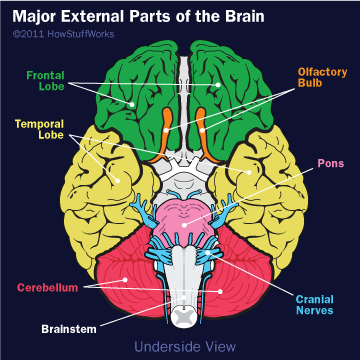

Every animal you can think of — mammals, birds, reptiles, fish, amphibians — has a brain. But the human brain is unique. Although it’s not the largest, it gives us the power to speak, imagine and problem solve. It is truly an amazing organ.
The brain performs an incredible number of tasks including the following:
All of these tasks are coordinated, controlled and regulated by an organ that is about the size of a small head of cauliflower.
Your brain, spinal cord and peripheral nerves make up a complex, integrated information-processing and control system known as your central nervous system. In tandem, they regulate all the conscious and unconscious facets of your life. The scientific study of the brain and nervous system is called neuroscience or neurobiology. Because the field of neuroscience is so vast — and the brain and nervous system are so complex — this article will start with the basics and give you an overview of this complicated organ.
We’ll examine the structures of the brain and how each section controls our daily functions, including motor control, visual processing, auditory processing, sensation, learning, memory and emotions.
Your brain is made of approximately 100 billion nerve called neurons. Neurons have the amazing ability to gather and transmit electrochemical signals — think of them like the gates and wires in a
Neurons share the same characteristics and have the same makeup as other , but the electrochemical aspect lets them transmit signals over long distances (up to several feet or a few meters) and send messages to each other.
Neurons come in many sizes. For example, a single sensory neuron from your fingertip has an axon that extends the length of your arm, while neurons within the brain may extend only a few millimeters.
They also have different shapes depending on their functions. Motor neurons that control contractions have a body on one end, a long axon in the middle and dendrites on the other end. Sensory neurons have dendrites on both ends, connected by a long axon with a cell body in the middle. Interneurons, or associative neurons, carry information between motor and sensory neurons.
These fundamental members of the nervous system also vary with respect to their functions.
The simplest type of neural pathway is a monosynaptic (single connection) reflex pathway, like the knee-jerk reflex. When the doctor taps the right spot on your knee with a rubber hammer, receptors send a signal into the spinal cord through a sensory neuron. The sensory neuron passes the message to a motor neuron that controls your leg muscles. Nerve impulses travel down the motor neuron and stimulate the appropriate leg muscle to contract. The response is a muscular jerk that happens quickly and does not involve your brain. Humans have lots of hardwired reflexes like this, but as tasks become more complex, the pathway circuitry gets more complicated and the brain gets involved.
The simplest possible creatures have incredibly basic nervous systems made up of nothing but reflex pathways. For example, flatworms and invertebrates don’t have centralized brains. They have loose associations of neurons arranged in straightforward reflex pathways. Flatworms have neural nets, or individual neurons linked together that form a net around the entire animal.
Most invertebrates (such as the lobster) have modest “brains” that consist of localized collections of neuronal cell bodies called ganglia. Each ganglion controls sensory and motor functions in its segment through reflex pathways, and the ganglia are linked together to form a simple nervous system. As nervous systems evolved, chains of ganglia evolved into more centralized simple brains.
Brains evolved from ganglia of invertebrates. Regardless of the animal, brains have the following parts:
Lower animals, such as fish, amphibians, reptiles and birds, don’t do much “thinking,” but instead concern themselves with the everyday business of gathering eating, drinking, , reproducing and defending themselves.
These are instinctual processes [source: ]. Therefore, their brains are organized along the major centers that control these function
We humans perform these functions as well, and so have a “reptilian” brain built into us. That means we have the same parts of the brain found in reptiles, namely the brain stem and the cerebellum.
Ready to learn about the lower brain? We’ll discuss that on the next page
What is the Main Cause of a Heart Attack? What is its Solution? A heart attack is the blockage of… Read More
In the vast economic arena, one term that often takes center stage, inciting extensive debates and discussions, is the "debt… Read More
De-Dollarization: The Changing Face of Global Finance The financial landscape is in a state of flux, with an intriguing economic… Read More
The curtains closed on a dramatic Bundesliga season with Bayern Munich standing tall once again, clinching their 11th straight title.… Read More
The Unfolding Story of Celine Dion's Health In recent news that has left fans across the globe stunned, iconic singer… Read More
As the echoes of the recent NBA season start to fade, the attention of enthusiasts is firmly glued to one… Read More
View Comments
Thank you for this piece of writing. Different form what is normally posted here on this. Very educational and worth the read.